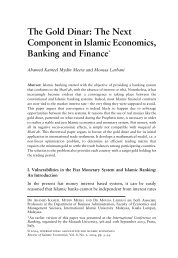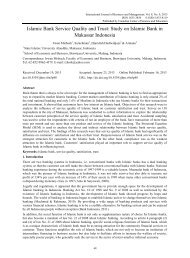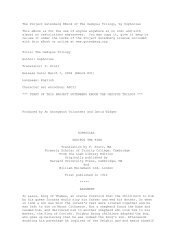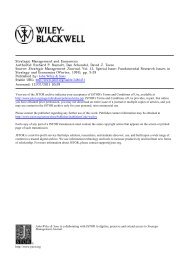The Oil Industry in Nazi Germany, 1936-1945
The Oil Industry in Nazi Germany, 1936-1945
The Oil Industry in Nazi Germany, 1936-1945
You also want an ePaper? Increase the reach of your titles
YUMPU automatically turns print PDFs into web optimized ePapers that Google loves.
NAZI OIL INDUSTRY 259<br />
later altered <strong>in</strong> the four-year plan, but give some <strong>in</strong>dication of the ex-<br />
tent of the government commitment to the development of the Ger-<br />
man petroleum <strong>in</strong>dustry.14 In addition, the four-year plan aided re-<br />
search <strong>in</strong> the <strong>in</strong>dustry. On the orders of G6r<strong>in</strong>g's Four-Year Plan<br />
Office, the Reich Institute for Petroleum Research, attached to the<br />
Technische Hochschule at Hannover, was created. Over one hundred<br />
employees researched technical improvements for the <strong>in</strong>dustry.'5<br />
Both the crude and the synthetic sectors of the German oil <strong>in</strong>dustry<br />
ga<strong>in</strong>ed from these and similar favorable developments dur<strong>in</strong>g the <strong>Nazi</strong><br />
period much more than did other German <strong>in</strong>dustries. <strong>The</strong> two sectors,<br />
however, did not ga<strong>in</strong> to the same degree or <strong>in</strong> the same way. To un-<br />
derstand the differences between the two sectors, and the reasons for<br />
those differences, it will be necessary to consider each sector sepa-<br />
rately and <strong>in</strong> some detail.<br />
THE GERMAN CRUDE OIL INDUSTRY<br />
German crude oil ref<strong>in</strong>eries, mostly located <strong>in</strong> northwest <strong>Germany</strong>,<br />
were supplied dur<strong>in</strong>g the 1930s with both imported and domestic<br />
crude oil. In general, over the course of the <strong>Nazi</strong> period there was<br />
some change <strong>in</strong> the ref<strong>in</strong>eries' source of supply. <strong>The</strong>y moved from us-<br />
<strong>in</strong>g imported crude almost exclusively to us<strong>in</strong>g much larger amounts<br />
of crude produced <strong>in</strong>digenously. <strong>The</strong> source of imported crude and<br />
other petroleum products also shifted-from overseas to eastern Eu-<br />
rope-and imports cont<strong>in</strong>ued to play a large role <strong>in</strong> ref<strong>in</strong>ery supply until<br />
nearly the end of the war. <strong>The</strong> expansion of the domestic crude <strong>in</strong>dus-<br />
try was accompanied by ever-stricter state control. Dur<strong>in</strong>g the same<br />
period, the capacity of the ref<strong>in</strong>eries themselves rema<strong>in</strong>ed about the<br />
same as <strong>in</strong> 1930-that is, about five million metric tons per year.'6<br />
<strong>The</strong> German crude oil <strong>in</strong>dustry was dom<strong>in</strong>ated throughout the 1930s<br />
and 1940s by six major companies, which together controlled 96 per-<br />
cent of all production <strong>in</strong> <strong>Germany</strong>. <strong>The</strong>se companies were Deutsche<br />
Erdol, Elwerath, W<strong>in</strong>tershall, Preussag, Deutsche Vacuum, and Bri-<br />
gitta (Shell). Unlike other <strong>in</strong>dustries <strong>in</strong> <strong>Germany</strong>, the crude <strong>in</strong>dustry<br />
" Petz<strong>in</strong>a, Autarkiepolitik, 45.<br />
15 Comb<strong>in</strong>ed Intelligence Objectives Subcommittee (CIOS) F<strong>in</strong>al Report 10 xxxii-94, "German Petro-<br />
leum <strong>Industry</strong>, Hamburg District," 12-27 May <strong>1945</strong>; E. H. Bower, report 13, "Reichs<strong>in</strong>stitut fiir Erdl-<br />
forschung der Technische Hochschule Hannover," 1, <strong>in</strong> box 11/27-1, Office of Military Government for<br />
<strong>Germany</strong> (U.S.), Headquarters, Legal Division, Decartelization Branch, RG 260, Wash<strong>in</strong>gton National<br />
Records Center, Suitlands, Md. (hereafter WNRC).<br />
16 U.S. Strategic Bomb<strong>in</strong>g Survey (European War), USSBS Report 113, <strong>The</strong> German <strong>Oil</strong> <strong>Industry</strong>,<br />
M<strong>in</strong>isterial Report Team 78, sec. 1.05, 14-15, and sec. 1.08, 30, <strong>in</strong> Records of the U.S. Strategic Bomb<strong>in</strong>g<br />
Survey (European War), RG 243, National Archives, Wash<strong>in</strong>gton, D.C. (hereafter NA). (This report is<br />
cited hereafter as German <strong>Oil</strong> <strong>Industry</strong>.) See Krammer, "Fuel<strong>in</strong>g," 408-9, for imports from eastern Eu-<br />
rope and German exploitation of oil from that area.












